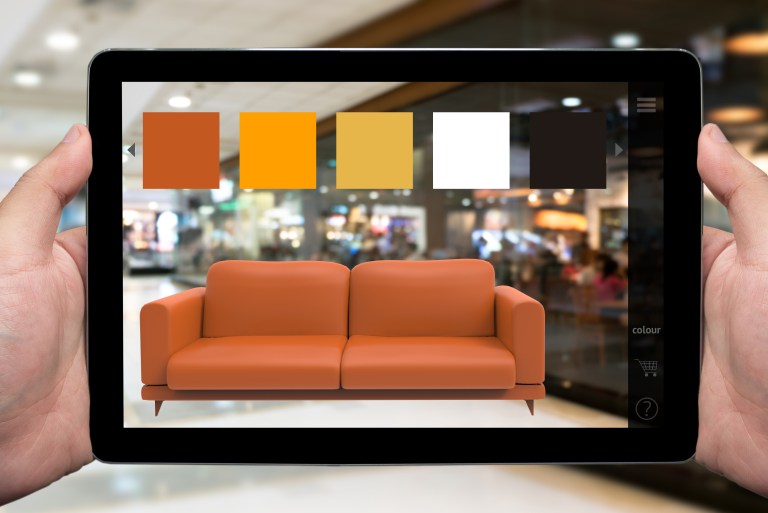
Reality may or may not bite, but virtual reality sells. In the latest Omnicommerce Tracker™, PYMNTS caught up with Beck Besecker, cofounder and CEO of AR and VR solution provider Marxent, to find out how augmented and virtual reality apps are turbo charging the consumer journey. You can find that, along with the latest headlines from around the omni space and a comprehensive provider directory, inside the latest Tracker.
Sometimes all it takes is a new way of looking at things to open up a world of possibilities — at least, that’s what retailers investing in augmented reality (AR) and virtual reality (VR) believe.
And there’s some evidence to back up that belief.
Because the technology allows consumers to increasingly interact with objects, no matter where they may be physically located, AR and VR also hold particular promise for merchants.
Research published in The Harvard Business Review in September 2016 predicted that this ability to “reshape retail” would power as much as $30 billion in AR and VR investments from retailers by the end of the decade. Meanwhile, other industry projections show that more than 800 million AR apps for retailers will be downloaded by consumers by 2019. Already, retailers like Converse, De Beers and Wayfair, among other big brands, have embraced the new technology.
And, according to Beck Besecker, co-founder and CEO of Marxent, AR and VR can have particularly large impacts on home furnishing retailers. Marxent designs AR and VR solutions for retailers, including several large home retailers like Ashley Furniture and Lowe’s, as well as several other stores.
Besecker told PYMNTS in a recent interview that this new technology is almost a perfect match for retailers like Ashley’s, Lowe’s and other home retailers, because the retailers sell items with big footprints and big price tags that typically require extra thought and consideration from consumers before they are ready to make a purchase.
“What we do is provide a really easy application that both consumers and sales associates can use to help a customer visualize their potential purchase as easily and quickly as possible,” Besecker explained. “You can use AR and VR technology to help give a preview of what an item looks like in a room in a highly realistic, very fast way.”
Giving Customers the Perfect Preview
Besecker noted that because Marxent’s partners often deal in big-ticket items, these purchases are not just costly, but likely to remain in a customer’s life for years, if not decades. So they want consumers to be as confident as possible upon purchase that they will like the products.
As a result, Marxent offers two different solutions. Each is designed to help consumers feel more confident in their purchases by allowing them to test or preview different items before pulling the trigger.
One is an AR solution, which allows customers to see what a couch or another piece of furniture will look like in a particular room, and the other is a VR solution that enables users to build their own room from scratch, testing different appliances or furniture in the virtual space.
Both applications, Besecker said, can help merchants shorten the time it takes to make a sale and increase their bottom line.
“The reason a retailer or manufacturer would offer this is simple: If they can see it, consumers will have a higher level of confidence,” he said. “We usually see a 50 percent shorter sales cycle, because people hesitate less if they can see it. It also increases the overall transaction size, which, in turn, increases on overall sales.”
Besecker also noted that these solutions are especially powerful for retailers’ mobile and online solutions.
While furniture and other home retailers have typically struggled to appeal to online shoppers because of that inability to test or preview an item, mobile and online solutions that use AR allow users to see how furniture might look in a room by standing in that room while wearing a VR headset, which projects the new items into their virtual room.
AR for All
While Marxent has attracted attention for partnerships with large national retailers like Ashley Furniture and Lowe’s, Besecker attested that AR and VR technology hold promise not just for big-name retailers, but for smaller merchants as well.
Besecker acknowledged that the tech’s high price tag could be a deterrent to smaller businesses, which do not have the resources to spend on cutting-edge technology, especially when there is so much still to be learned about it and the effects it can have for merchants.
However, despite this, Besecker said that new solutions or strategies could open up the technology to retailers of all shapes and sizes, from national chains to local mom-and-pop storefronts.
“The reality is that something like this solution works, for every retailer and manufacturer, big or small,” Besecker said. “So we’re looking at helping smaller retailers that want something like this but can’t afford to make a big investment via a third-party application, before helping them roll it out under their own umbrella and user experience.”
With AR and VR technology becoming more commonplace, when consumers shop for home goods at stores big and small, they may increasingly make purchases more confidently with the help of a virtual preview — boosting the bottom line for retailers and manufacturers in the process.
To download the March edition of the PYMNTS.com Omnicommerce Tracker™, click the button below…
About the Tracker
The Vantiv Omnicommerce Tracker™, powered by PYMNTS.com, features industry-spanning research and insights that arm retailers with data to make smarter decisions for enabling omnichannel commerce.